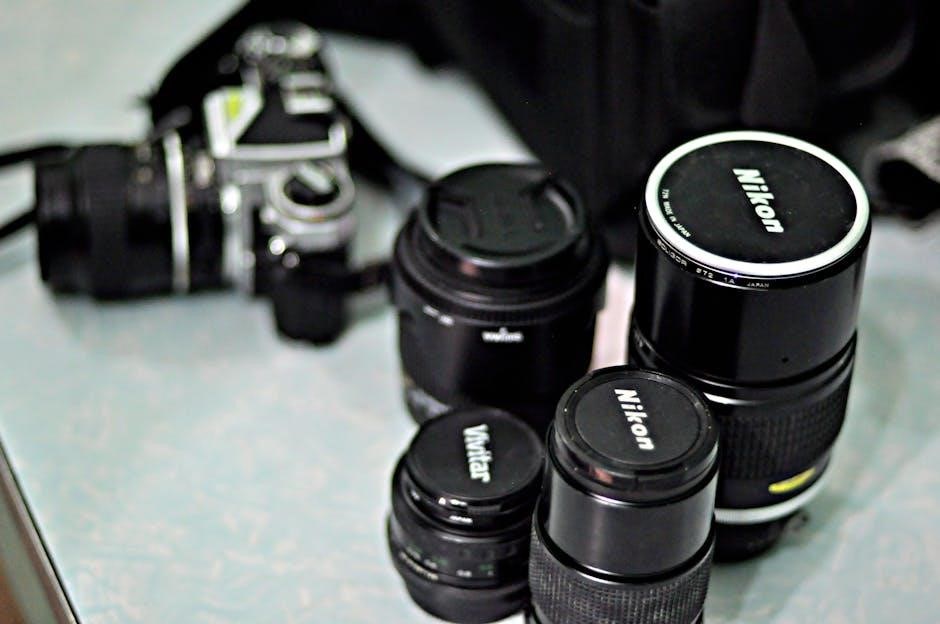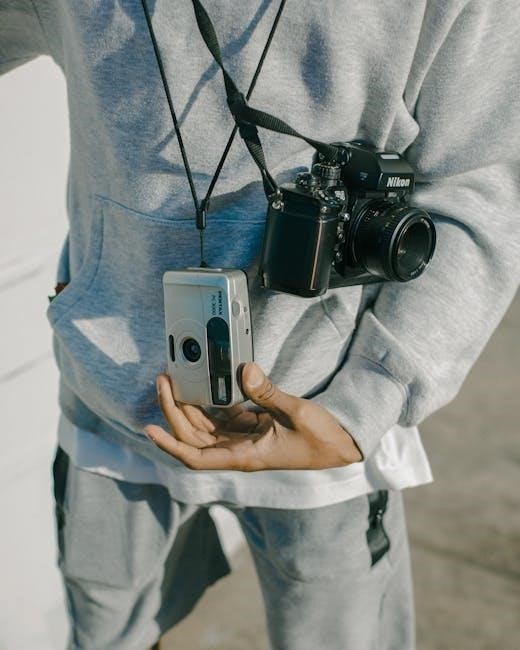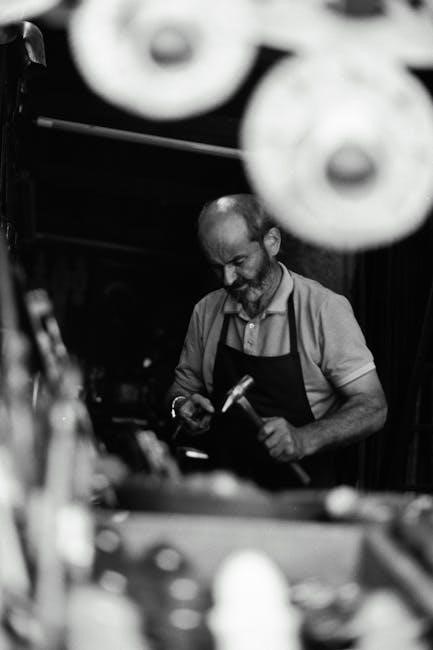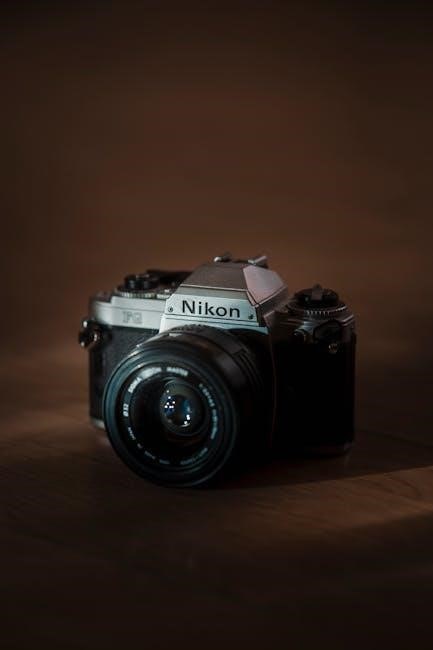Nikon D80 Manual: A Comprehensive Guide
Welcome to your comprehensive guide to the Nikon D80! This guide provides an in-depth exploration of your camera, from initial setup and basic operations to advanced techniques and troubleshooting. Let’s unlock the full potential of your Nikon D80 and elevate your photography skills today.
Understanding the Nikon D80
The Nikon D80 is a digital SLR camera boasting a 10.2-megapixel CCD sensor, delivering detailed and high-resolution images. This camera is designed for both enthusiasts and experienced photographers alike. It offers a blend of performance, image quality, and user-friendly features. Understanding the core components and capabilities of the D80 is crucial to maximizing its potential.
This section will walk you through the key aspects of the camera’s design and functionality. You’ll gain insights into its image processing capabilities, the significance of its sensor, and how these elements contribute to the overall image quality. We will also explore the camera’s physical attributes, including button layouts and dial functions. Familiarizing yourself with these basics will empower you to navigate the camera’s settings and capture stunning photographs with confidence.
Whether you’re new to DSLRs or an experienced shooter, this section provides a foundation for mastering the Nikon D80. It bridges the gap between technical specifications and practical application, ensuring you’re well-equipped to make the most of this versatile camera.

Key Features and Specifications
The Nikon D80 is equipped with several key features that contribute to its performance and versatility. At its heart is a 10.2MP CCD sensor, responsible for capturing detailed images with impressive clarity. The camera also features a 2.5-inch LCD screen with a 230,000-pixel resolution for reviewing photos and navigating menus. Understanding these specifications is crucial for optimizing your shooting experience.
The D80 boasts a range of shooting modes, including aperture-priority, shutter-priority, and manual modes, giving you precise control over exposure settings. Its advanced autofocus system ensures sharp and accurate focusing, even in challenging conditions. The camera is also compatible with a wide range of Nikon lenses, further expanding its creative potential.
Furthermore, the D80 supports various ISO settings, allowing you to adapt to different lighting scenarios. Its built-in flash provides additional illumination when needed. These features, combined with the camera’s intuitive interface, make the Nikon D80 a powerful tool for capturing stunning images across a wide range of photographic styles.
CCD Sensor and Image Quality
The Nikon D80 features a 10.2-megapixel CCD sensor. This sensor is instrumental in capturing high-resolution images with clarity and detail. The CCD technology contributes to the camera’s ability to produce images with vibrant colors and a wide dynamic range, essential for capturing scenes accurately.
The sensor’s size and design directly impact image quality. The D80’s CCD sensor allows for larger individual pixels, which gather more light and reduce noise, especially in low-light conditions. This results in cleaner images with improved detail, even at higher ISO settings. Understanding the sensor’s capabilities is crucial for maximizing image quality.
Image quality is further enhanced by Nikon’s image processing engine, which optimizes color reproduction, sharpness, and overall image rendering. The combination of the CCD sensor and advanced processing ensures that your photos are visually appealing and accurately represent the scenes you capture. This is a key aspect of the Nikon D80’s performance.
LCD Display and Resolution
The Nikon D80 is equipped with a 2.5-inch LCD display. This screen serves as a primary interface for reviewing images, navigating menus, and adjusting camera settings. The display’s size provides a comfortable viewing experience, allowing users to assess composition and sharpness in the field.
The LCD display features a resolution of 230,000 pixels. While this resolution might seem modest by modern standards, it offers sufficient clarity for basic image review and menu navigation. The screen allows users to check exposure, color balance, and composition to make necessary adjustments before capturing the final image.
Despite its limitations compared to higher-resolution displays, the D80’s LCD screen is functional and reliable. It provides essential feedback for photographers to evaluate their shots and fine-tune settings. The display’s brightness and contrast can be adjusted to suit various lighting conditions, ensuring visibility in bright sunlight or dimly lit environments. It remains an integral part of the camera’s user experience, enabling effective operation and control.
Basic Operations and Settings
Mastering the basic operations and settings of your Nikon D80 is essential for capturing great photos. Start by understanding the various shooting modes, such as Auto, Program, Aperture Priority, Shutter Priority, and Manual. Auto mode simplifies the process by letting the camera handle most settings, ideal for beginners.
Explore the menu system to adjust image quality, size, and ISO settings. Setting the correct ISO is crucial for managing image noise in different lighting conditions. Learn how to use the autofocus system effectively, selecting focus points to ensure sharp images. Familiarize yourself with the exposure compensation feature to fine-tune brightness levels.
Understanding white balance settings allows you to achieve accurate colors in various lighting situations. Experiment with different metering modes to control how the camera measures light. These fundamental operations and settings will empower you to take control of your photography and capture the images you envision with your Nikon D80.
Quick Start Guide
Embarking on your photographic journey with the Nikon D80 is made simple with this quick start guide. First, ensure your battery is charged and inserted correctly, along with an SD card for storing your photos. Attach your desired lens securely, aligning the mounting marks.
Power on the camera using the on/off switch. The LCD screen will display essential information. Set the mode dial to ‘Auto’ for a fully automatic shooting experience. Frame your subject using the viewfinder or the LCD screen in Live View mode (if supported).
Half-press the shutter button to activate autofocus, and once the subject is in focus, fully press the shutter button to capture the image. Review your photo by pressing the playback button. Explore basic menu options for adjusting image size and quality. This quick start will have you snapping photos confidently with your Nikon D80 in no time, ready to explore more advanced settings.
Menu Functions and Custom Settings
Delve into the Nikon D80’s menu functions to tailor your camera to your specific shooting style. Access the menu by pressing the ‘Menu’ button. Navigate through various sections like ‘Playback,’ ‘Shooting,’ ‘Custom Settings,’ ‘Setup,’ and ‘Retouch’ using the multi-selector.

Within ‘Shooting,’ adjust image quality, size, ISO sensitivity, white balance, and exposure compensation. ‘Custom Settings’ allows for personalization of camera controls, autofocus behavior, metering modes, and display options. Explore options to fine-tune settings to your preferences.

The ‘Setup’ menu enables you to configure date/time, language, LCD brightness, and other system-level settings. ‘Retouch’ offers in-camera image editing capabilities. Understanding these menu functions and custom settings unlocks the full potential of your Nikon D80, allowing for precise control over your photographic output and enhances your creative vision.
Troubleshooting and Maintenance
Encountering issues with your Nikon D80? This section provides guidance for common problems. If the camera doesn’t power on, check the battery’s charge level and ensure it’s correctly inserted. For focusing problems, verify the lens is securely attached and set to autofocus mode if needed. Clean the lens contacts and sensor regularly to maintain image quality.
If images appear over or underexposed, review your exposure settings, including aperture, shutter speed, and ISO. If the LCD display is dim or unresponsive, adjust its brightness or check the battery. Always use a soft, dry cloth to clean the camera body and lens elements.
Store your Nikon D80 in a cool, dry place when not in use. If problems persist, consult the complete user manual or seek assistance from a qualified Nikon service center. Regular maintenance and prompt troubleshooting will keep your Nikon D80 in optimal condition, ensuring years of reliable performance.
Downloading and Accessing the Manual

Accessing the Nikon D80 manual is straightforward. You can typically find the manual as a PDF download on the official Nikon website or through reputable online sources. Before downloading, ensure the source is legitimate to avoid malware or incorrect information.
Once downloaded, the PDF manual can be viewed on your computer, tablet, or smartphone. Consider using a PDF reader that allows you to search for specific keywords or topics. Alternatively, some websites offer online versions of the manual for easy browsing.
If you prefer a physical copy, you might find original instruction manuals available for purchase online. Remember to review the download agreement and disclaimer before downloading any manual. Having the manual readily accessible, whether digitally or physically, is essential for understanding all the features and functionalities of your Nikon D80, ensuring you maximize its potential.
